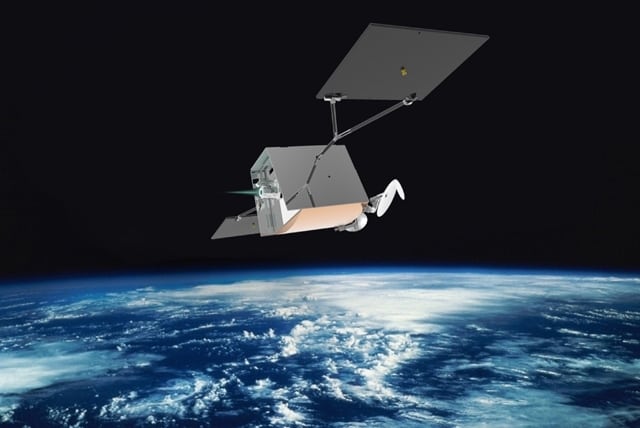Latest News

Rendition of one of OneWeb’s broadband smallsats. Photo: OneWeb.
Earmarked by SpaceX’s historic relanding of a first stage booster, 2017 was a banner year for the satellite industry in many respects. 2018 could prove to be even more momentous, as the smallsat megaconstellations that have been under development for years finally emerge — along with the dedicated smallsat launch vehicles that will serve them. In an interview with Via Satellite, Northern Sky Research (NSR) analyst Carolyn Belle laid out her expectations for the year ahead, as well as how these new systems could affect the broader satellite industry as they come online.
Overall, 2017 was a “very good year” for smallsat launch rates, Belle said, with the industry orbiting 329 smallsats (between 1 and 500 kg) in total. This is the highest number launched in one year to date, easily outstripping the mere 130 orbited in 2016. While the Indian Space Research Organization’s (ISRO) record-breaking launch of 105 satellites was a bit of an outlier, Belle believes the growing smallsat trend is here to stay.
“Given that we’re seeing much more interest from launch providers to support rideshare missions, as well as the upcoming availability of dedicated smallsat launchers, it should be a more conducive atmosphere for smallsat launch rates to increase,” she said.

Northern Sky Research analyst Carolyn Belle. Photo: NSR.
In 2017, many of those launches had been for Earth Observation (EO) spacecraft, such as Planet’s. Now, though, multiple companies building out broadband megaconstellations are reaching the final stretch of their developmental phases. Notably, OneWeb is opening its satellite manufacturing facility in Exploration Park, Florida later this year, and plans to orbit its first two test satellites by May. SpaceX will also launch the first prototype of its Low Earth Orbit (LEO) broadband network in the next couple of months. Combined, these two constellations comprise literally thousands of satellites — and there are others on the horizon too, such as Telesat and LeoSat.
NSR estimates that less than half of the currently proposed constellations will actually be successful. Nonetheless, their emergence is breathing new life into the industry, as both satellite manufacturers and launch providers compete for their contracts.
Manufacturers in particular seem grateful for the new potential business. Demand for Geosynchronous Earth Orbit (GEO) satellites have plummeted in recent years, culminating in just nine orders in 2017. “That was a more significant decline than anything we’ve seen before,” Belle said. “That was the lowest number in more than a decade.”
Global capacity pricing continues to sink like an anchor, making operators very cautious about their investments, Belle said. There has also been an influx of new technologies such as Extreme High Throughput Satellites (XTS) and software-defined payloads. This, combined with uncertainty about the value of Non-Geosynchronous Orbit (NGSO) systems, has left operators holding their capex close to the chest as they wait to see how these variables will play out.
As a result, manufacturers are hopeful these new megaconstellations could provide a reliable source of income even as the GEO side remains paltry. “You see manufacturers fairly hungry for these constellation contracts. They represent a very good source of business because it’s a high number build order,” Belle said. “Also, given the shorter lifespan of the satellites it presents an ongoing source of business for their replenishment. That may be re-competed [for] down the line but it does put whoever wins the first contract in a good position.”
The timing coincides neatly with the multiple smallsat launch providers that are almost ready to bring their new vehicles to market. Rocket Lab, Vector and Virgin Orbit have all scheduled test flights of their first rockets this year. Once one or more of these vehicles reaches an operational flight level, it should be significantly easier for smallsat operators to get their payloads into orbit, Belle said. New rideshare options offered by companies like Spaceflight Industries should improve launch availability as well.
“I’m cautiously optimistic about the smallsat-dedicated launch market finally progressing,” Belle said. “We’ve seen delays across many of the providers over the last few years but some of them now progressing through a few preliminary tests that will pave the way toward a full test flight. Some of those may well delay into 2019 but hopefully we’ll see a couple test flights this year.”
Still, even if satellite manufacturers and launch providers rise to the challenge, there remain noteworthy obstacles to the success of these smallsat megaconstellations. “Of the NewSpace constellations being planned, some of them are going after entirely new markets … It is a challenge to develop that demand, to convince a customer who’s never used a satellite product before that you can bring value to their organization,” Belle said. “Now that we’re seeing five or six or more players going after the same market, the question is will each of them be able to capture enough market share to sustain their operations?”
Get the latest Via Satellite news!
Subscribe Now